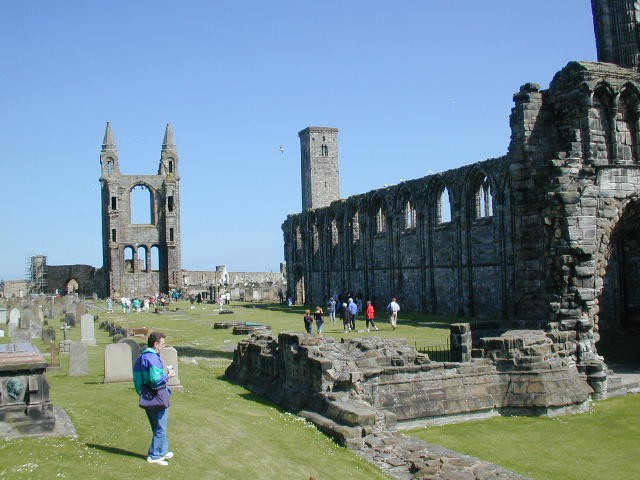

Today we had the morning free to explore Dunkeld, the town where our hotel is; Cheryl and I slept in, having spent some late nights recently. So I'll start with the afternoon, which we spent in St. Andrews. Legend holds that St. Rule, the Greek monk who was the guardian of the bones of St. Andrew in the 4th century, was warned by an angel in a vision that he should take the bones out of the reach of the Roman emperor by going with them to "the western edge of the world." After a long journey he was shipwrecked, and swam ashore with the relics tied about his waist, landing at the site that has since become the town of St. Andrews. The cathedral was built between 1160 and 1318; the long construction period included some major collapses of partially-constructed walls and also interruptions due to wars. The cathedral was the center of worship in Scotland, and was appropriately grand, with 31 altars! In 1559, during the Reformation, a particularly fiery anti-Catholic sermon incited a Protestant mob to destroy the altars, images, and decorations of the cathedral; it subsequently fell out of use, and over the next couple of centuries its walls were used as quarries for building stones in town.
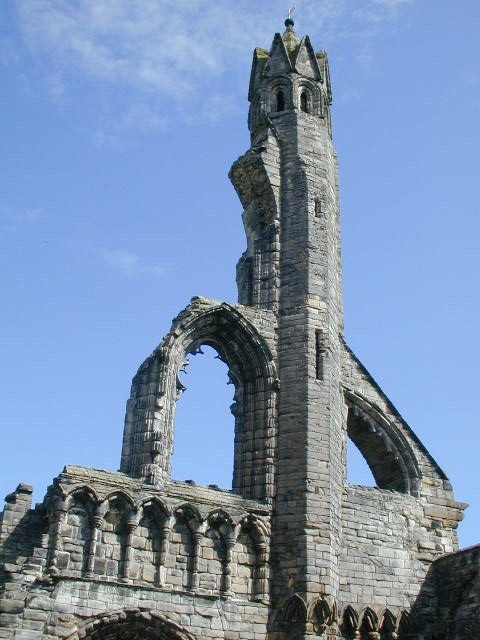
This is what remains of the west wall of the cathedral; you can compare it with the east wall, which is more complete (both spires remain) in the background of the picture at top. The skeletal remains reminded me of the cathedral of Coventry, bombed out during the Second World War, and left in that state as a memorial.
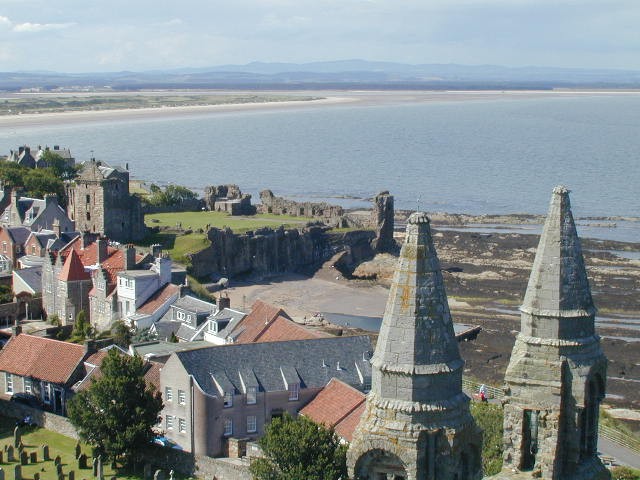
The square-cornered tower in the picture at the top of this page is the tower of St. Rule, the remnant of the Church of St. Rule that was replaced by the cathedral. Here is a view from the top, looking down over the east wall and out toward St. Andrews Bay and the ruined castle of St. Andrews. This was built in about 1200, destroyed during war and rebuilt in 1385, and also had a history of destruction during the Reformation. In 1546 Cardinal David Beaton, whose residence was the castle, caused a Protestant preacher named George Wishart to be burned at the stake outside the castle. A couple of months later Protestants took over the castle and assassinated Beaton, beginning a siege that ultimately ended with a bombardment by the French fleet, who came in to aid local Catholic rulers. Archbishop John Hamilton repaired the damage caused by the siege and bombardment, but the castle declined with the cathedral and ultimately parts either collapsed into the bay or were broken up for building stone.
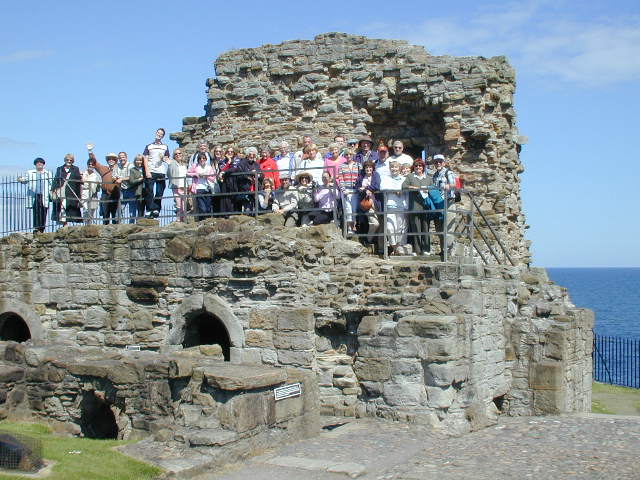
We actually had started the afternoon all together in the castle, then went our separate ways until we had to re-board the buses; here are many of our group on the remains of a seaward tower of the castle.
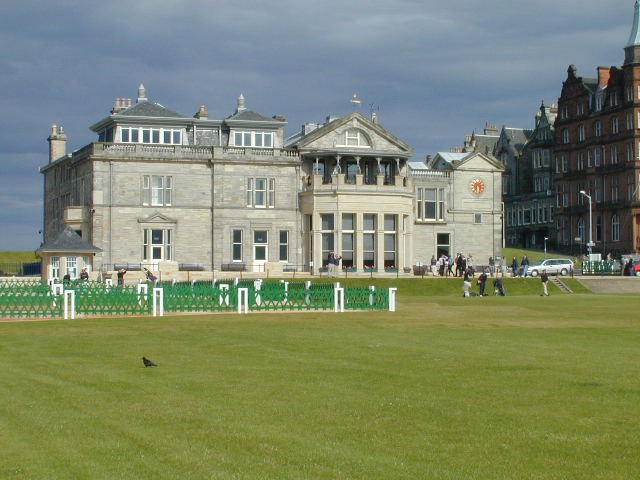
Of course, besides the ruined cathedral and the thriving St. Andrews University, the town is also famous for its Royal and Ancient Golf Club. Here is the clubhouse and the first tee of the Old Course. The earliest written record of golf is in a charter from Archbishop John Hamilton (the same as the repairer of the castle) in 1552, confirming the right of the townspeople to play golf on "the links." I have always heard golf courses referred to as "the links," but never knew why this was; I learned that "links," from an old Scottish word, refers to the strip of land between the shore and agricultural areas. Since such land is not very useful for anything else, it is a good place to dedicate to a golf course, and many golf courses in Scotland are on "the links," so that the term has been adopted worldwide.
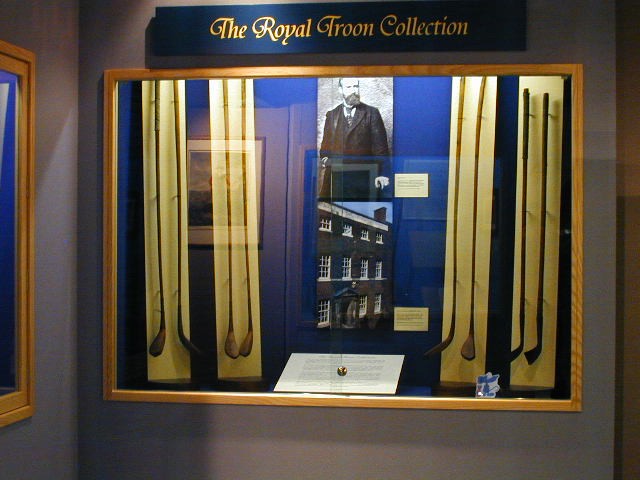
Across the street behind the clubhouse is the British Golf Museum. Exhibits there include a history of golf and of the Royal and Ancient Golf Club, many artifacts from the history of golf, and a small putting range where you can compare old types of balls and clubs with modern ones! The picture shows one of the rarest artifacts, a set of six woods and two irons that were found during renovation of a house in 1898; these are thought to be the oldest golf clubs in existence, and are on loan from the Royal Troon Golf Club. The woods probably date to the early 18th century, and the irons to the late 17th century. As a note of local (to us) interest, theatrical producer Arthur Lewis is a client of Steve Campbell, and his son Peter Lewis is the director of the museum; when we went in we found the Campbells just returning from meeting him. He gave them several books on the history of golf, including some he authored!
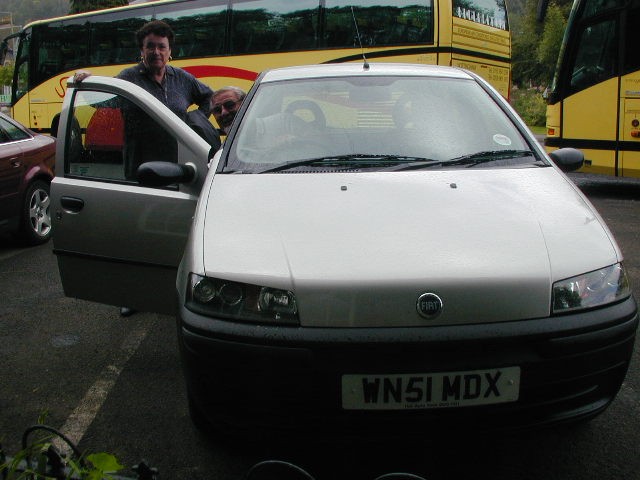
Not everybody went to St. Andrews; here are Jim and Sara Sellars getting ready to leave in a rental car, a right-hand-drive, stick-shift Fiat, instead of our buses. They had been there before (in fact, Jim has played at the Royal and Ancient Club!), so they went off to look up a local acquaintance. We'll have to see when they return how they did driving on the other side of the road!

One reason we decided to come to Dunkeld was that Caroline Rice has family there! After we returned, we walked a short distance from the hotel to the house of her brother Alasdair Wylie and his wife Vicki Hammer, to meet them and enjoy drinks and dessert. One special treat they had prepared for us was cranachan, which is a mix of cream, whisky, oatmeal, and berries; not too sweet, and with an interesting texture. Others of Caroline's family were there too; seated is her mother Dorothy Wylie, and standing from left to right are Vicki, Caroline, Alasdiar, and Val Wylie, wife of Caroline's other brother Chris Wylie, who was unable to attend. The choir was most grateful for their hospitality, which was a great way to end the day!
 To
Saturday, 6 July 2002
To
Saturday, 6 July 2002 Back
to choir tour itinerary
Back
to choir tour itinerarynew 5 July 2002, revised 21 July 2002